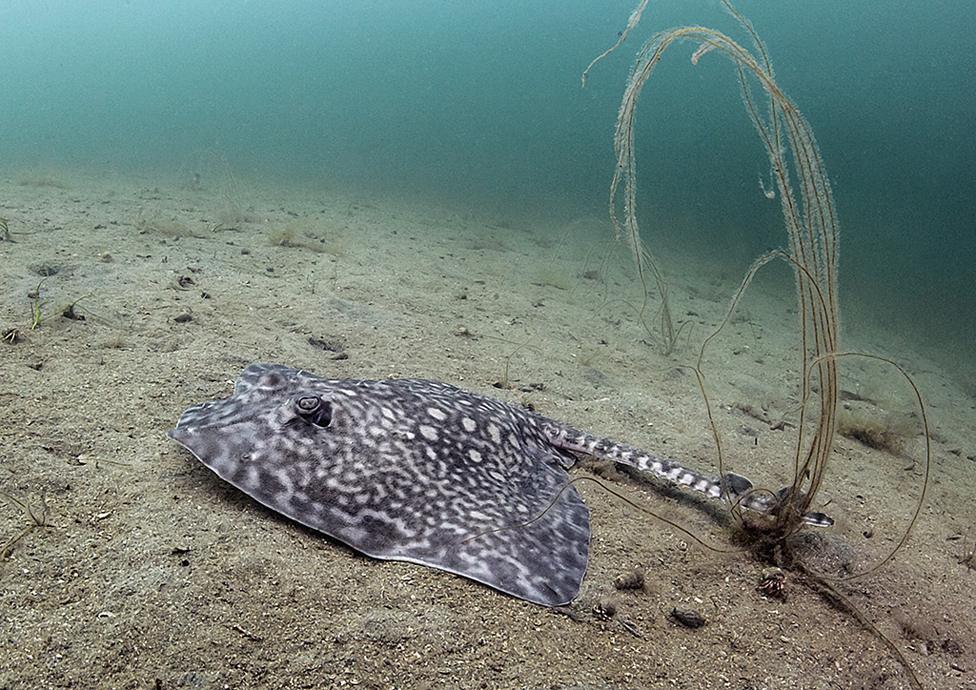Highly Protected Marine Areas: Three sites secure environmental protection
- Published

North East of Farnes Deep - in the North Sea - teems with starfish
The first three Highly Protected Marine Areas (HPMAs) have come into force.
It is part of government plans to bring in tighter controls to protect habitats and species against pollution and activity such as dredging and trawling.
Allonby Bay off the Solway Firth, Cumbria, North East of Farnes Deep off Northumberland, and Dolphin Head, West Sussex, have been chosen.
Marine minister Lord Benyon called it a "crucial part" of aquatic protection measures, with more to be announced.
The government said the three areas were chosen for the "ecological importance of nature recovery" and their "social and economic impacts", following a 12-week consultation.
In February, controversial plans which might have seen Holy Island in Northumberland included were abandoned after an outcry from the local fishing industry.
The Scottish government also scrapped its plans to create HPMAs in 10% of Scotland's seas, following concerns by fishers and some island communities.

The Department for Environment, Food and Rural Affairs (Defra) said there was evidence that better protection could lead to more and larger species in English seas and surrounding waters, "contributing to the long-term productivity and sustainability of our fisheries sector".
It highlighted the Lyme Bay reserve, external off the coast of Dorset - one of the largest areas protected from dredging and trawling in the UK - which it said demonstrated higher levels of biodiversity by conserving species such as pink sea fans, lobsters and scallops.
"Today is a significant milestone for the UK as we ramp up action to recover our important marine ecosystems, and make sure species and habitats can thrive in healthy, diverse environments," Lord Benyon added.
Allonby Bay was chosen because it is an area of "significant importance" due to its so-called blue carbon habitats which capture and store carbon, helping to tackle climate change.
The protection of this site also benefits a number of shore birds - such as curlews and oystercatchers - that are attracted to the unique habitats, Defra said.

Allonby Bay is a spawning area for Thornback rays
It said North East of Farnes Deep's complex seabed habitat will benefit, with commercially important fish such as haddock, anglerfish (monkfish) and surmullet (also known as red mullet) "better protected" due to the crucial spawning and nursery habitats the site provides.
The protection of Dolphin Head, which has been "degraded" in recent years through trawling and scallop dredging, would potentially see a "full recovery" of habitats and species.
Defra said aside from attracting a range of seabirds and marine mammals - such as black-legged kittiwake and harbour porpoise - the site contained feeding and nursery grounds of important commercial fish species including cod, herring, plaice as well as ecologically important habitats such as ross worm reefs.

Spider crabs are common in shallow waters off England
Tony Juniper, chair of Natural England, said the HPMAs would "help boost the long-term sustainability of these areas of ocean, helping to soften some impacts of climate change while aiding the recovery of marine ecosystems and the fish, marine mammals and seabirds that depend upon them".
Joan Edwards, director of policy and public affairs at The Wildlife Trusts, added: "These three tiny spots cover just 0.4% of English seas - and we're looking forward to seeing further designations so that we can safeguard our seas for the future."

Follow BBC North East & Cumbria on Twitter, external, Facebook, external and Instagram, external. Send your story ideas to northeastandcumbria@bbc.co.uk, external.
- Published28 February 2023

- Published29 June 2023

- Published25 February 2023
